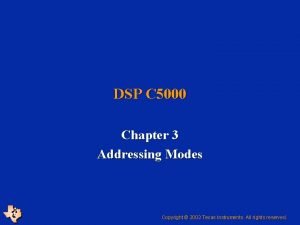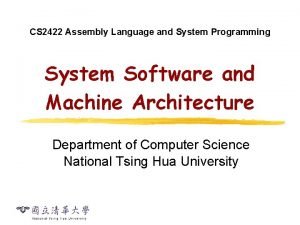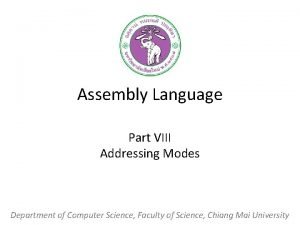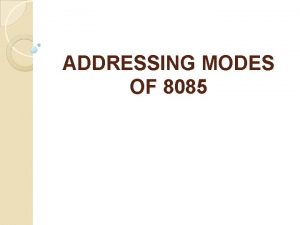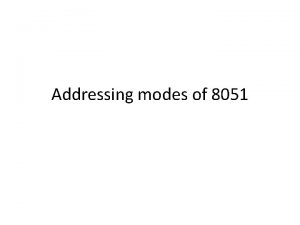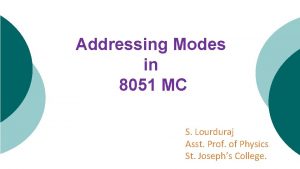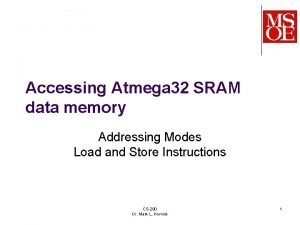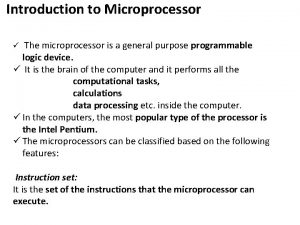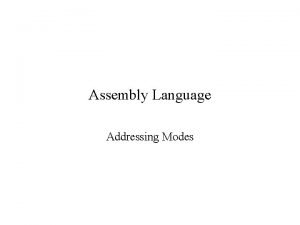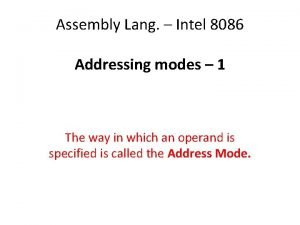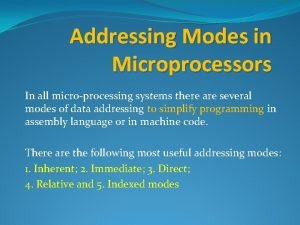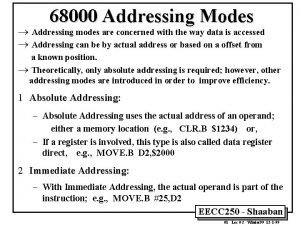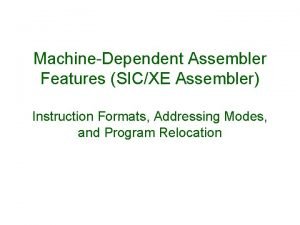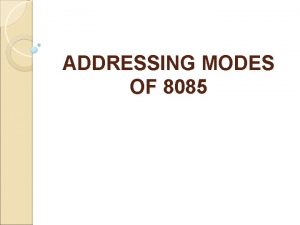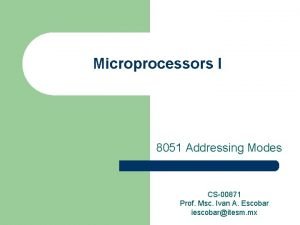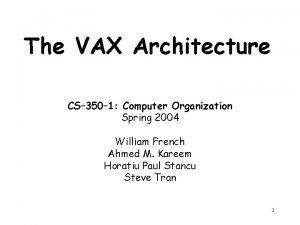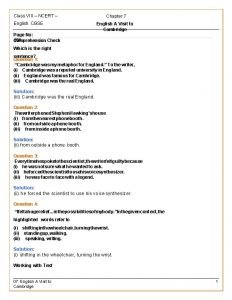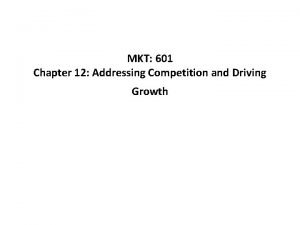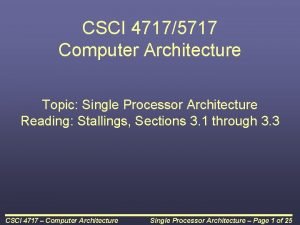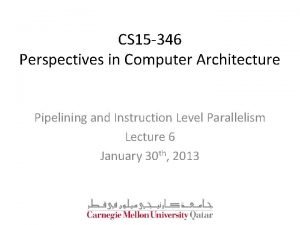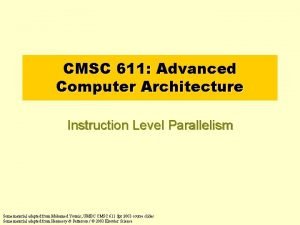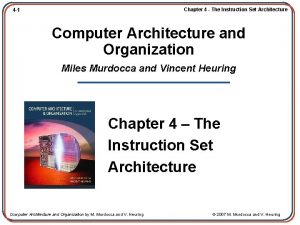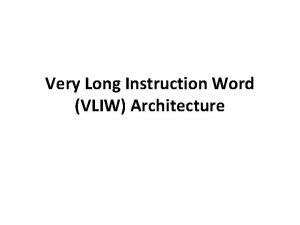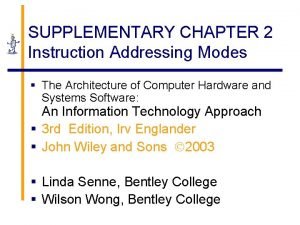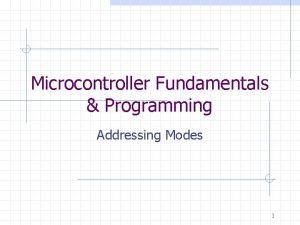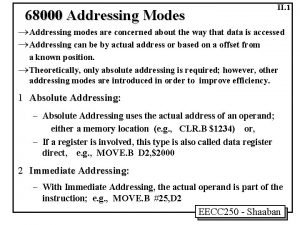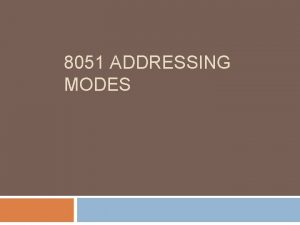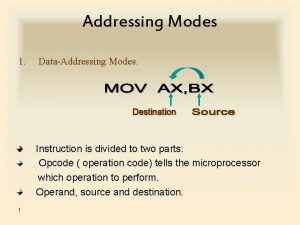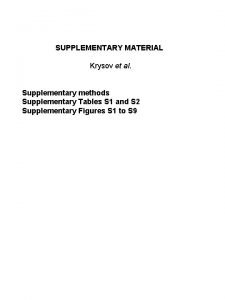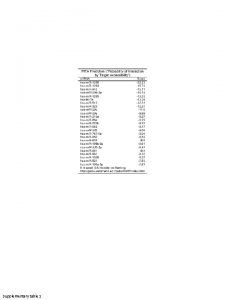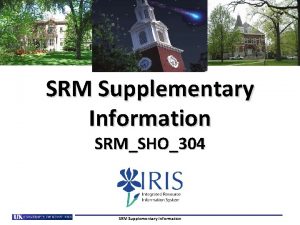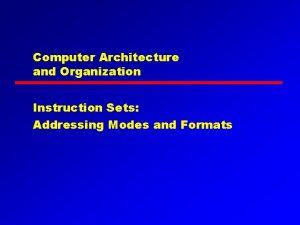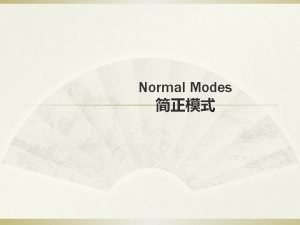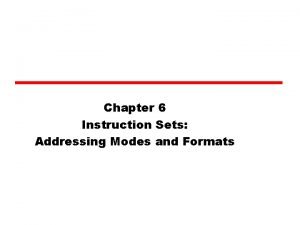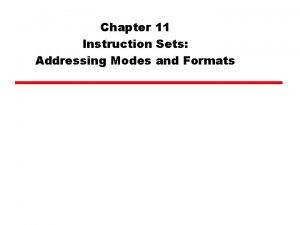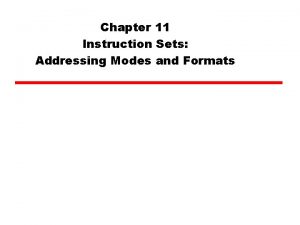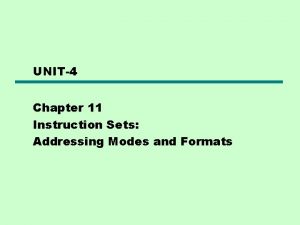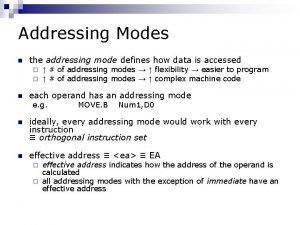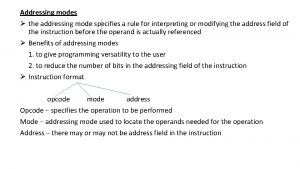SUPPLEMENTARY CHAPTER 2 Instruction Addressing Modes The Architecture





































- Slides: 37

SUPPLEMENTARY CHAPTER 2 Instruction Addressing Modes § The Architecture of Computer Hardware and Systems Software: An Information Technology Approach § 3 rd Edition, Irv Englander § John Wiley and Sons 2003

Little Man Computer § Direct, absolute addressing § Direct: data is reached directly from the address in the instruction § Absolute: address in the instruction field is the actual memory location being addressed Supplementary Chapter 2 Instruction Addressing Modes 2

Additional Addressing Modes § Programmer-accessible registers § Provide faster execution with register-based instructions § Alternatives to absolute addressing § Allow larger range of addressable memory § While using a reasonable number of bits for the address field § Alternatives to direct addressing § Facilitate writing certain types of programs § Example: loops that use index to address different entries in a table or array Supplementary Chapter 2 Instruction Addressing Modes 3

Register Addressing § Does not require a memory access § Faster execution § Implemented directly as part of the CPU § RISC machine instruction set: made up almost entirely of register operation instructions Supplementary Chapter 2 Instruction Addressing Modes 4

Register Addressing Fetch-Execute Cycle for Register-to-Register Move 1. PC -> MAR Transfer the address from the PC to the MAR 2. MDR -> IR Transfer the instruction to the IR 3. contents(IR[add 1]) -> contents(IR[add 2]) Move contents of source register to destination register 4. PC + 1 -> PC Program Counter incremented* *Done in parallel with move; only 3 time units required Supplementary Chapter 2 Instruction Addressing Modes 5

Additional Addressing Modes § Programmer-accessible registers § Provide faster execution with register-based instructions § Alternative to absolute addressing § Allow larger range of addressable memory § While using a reasonable number of bits for the address field § Alternative to direct addressing § Facilitate writing certain types of programs § Example: loops that use index to address different entries in a table or array Supplementary Chapter 2 Instruction Addressing Modes 6

Active Area of Memory § Code executes in a small area of memory that changes as program proceeds § Well-written code Fig S 2. 2 § Small modular subroutines and procedures § Local variables § Conditional branches Supplementary Chapter 2 Instruction Addressing Modes 7

2 Alternatives to Absolute Addressing § Base register addressing § Relative addressing § Both provide starting address and an offset or displacement from the starting point Starting address in register or program counter p Offset: address in the instruction p § Programming advantage: relocatability Supplementary Chapter 2 Instruction Addressing Modes 8

Base Register Addressing § Base register set to initial address § Hardware design: special, separate register or general-purpose registers § Generally large to provide large memory space, frequently gigabytes § Final address: contents of instruction address field added to the base address Supplementary Chapter 2 Instruction Addressing Modes 9

IBM z. System § Base register address creation Base 1375 Register 1 1375 + 20 Instruction 20 = 1395 actual location (absolute address in memory) Supplementary Chapter 2 Instruction Addressing Modes 10

IBM z. System § 16 64 -bit general-purpose registers § Load instruction format op code bit 0 7 Supplementary Chapter 2 Instruction Addressing Modes reg # 8 index 11 12 base # 15 16 19 displacement 20 31 11

IBM z. System Example: Load § Base-value register: general-purpose register 3 1 C 2 5 E 016 § Displacement for the instruction 3 7 A 16 § Absolute address 1 C 2 5 E 016 3 7 A 16 = 1 C 2 9 5 A 16 Supplementary Chapter 2 Instruction Addressing Modes 12

IBM z. System Example: Load § Instruction Word Op code 58 Base register 6 0 Destination register Supplementary Chapter 2 Instruction Addressing Modes 3 37 A Displacement 13

Fetch-Execute Cycle for Relative Address 1. PC -> MAR Transfer the address from the PC to the MAR 2. MDR -> IR Transfer the instruction to the IR 3. IR[Address] + PC -> MAR Address portion of the instruction added to the PC and loaded into the MAR 4. MDR + A -> A Value in the MDR added to the value of the accumulator 5. PC + 1 -> PC Program Counter incremented Supplementary Chapter 2 Instruction Addressing Modes 14

Relative Addressing § Value in address field added to value in program counter § Program counter used as the base register § Similar to base addressing § Constraint: address field must be able to store and manipulate positive and negative numbers § Complementary representation Supplementary Chapter 2 Instruction Addressing Modes 15

Relative Addressing Example Program Counter 46 1 46 + = 49 Supplementary Chapter 2 Instruction Addressing Modes 3 Instruction 3 actual location (absolute address in memory) 16

Direct Addressing § Separates data into location different from location of instructions § Benefits to programmer § Data can be changed without affecting the instruction itself § Data is available to different instructions Supplementary Chapter 2 Instruction Addressing Modes 17

Additional Addressing Modes § Programmer-accessible registers § Provide faster execution with register-based instructions § Alternative to absolute addressing § Allow larger range of addressable memory § While using a reasonable number of bits for the address field § Alternative to direct addressing § Facilitate writing certain types of programs § Example: loops that use index to address different entries in a table or array Supplementary Chapter 2 Instruction Addressing Modes 18

Alternatives to Direct Addressing § § Immediate addressing Indirect addressing Register Indirect addressing Indexed addressing Supplementary Chapter 2 Instruction Addressing Modes 19

Immediate Addressing § Store data with the instruction itself § Example: p Data is a constant § Constraint: Address field must be able to store and manipulate positive and negative numbers p Complementary representation p § Advantage: Additional memory access not required p Faster execution p Supplementary Chapter 2 Instruction Addressing Modes 20

Immediate Addressing § Modified LMC Example § Constant limited to the size of address field op code addressing mode 1 (Load) Supplementary Chapter 2 Instruction Addressing Modes 1 address field 05 (the number 05) 21

Immediate Addressing § Modified LMC Example 1. PC -> MAR Transfer the address from the PC to the MAR 2. MDR -> IR Transfer the instruction to the IR 3. IR[Address]-> A Move contents of source register to Accumulator 4. PC + 1 -> PC Program Counter incremented Supplementary Chapter 2 Instruction Addressing Modes 22

Indirect Addressing § Address field of the instruction contains the address of the data § Similar to pointers in Pascal or C § Frequently used with subscripted data in a table Memory address Data Table Subscript 77 136 TABLE(1) 78 554 TABLE(2) 79 302 TABLE(3) : Supplementary Chapter 2 Instruction Addressing Modes 23

Little Man Indirect Addressing a. The Little Man reads in instruction b. , , , he finds the address of the data Supplementary Chapter 2 Instruction Addressing Modes 24

Little Man Indirect Addressing c. … from that address he retrieves the data d. … with a different address in location 45, he retrieves different data (note: In this step the address of the data has been incremented). Supplementary Chapter 2 Instruction Addressing Modes 25

Incrementing § Treat the instruction as data § Modify the address field § Pure code: does not modify itself during execution § Incrementing does not modify the instruction § Address stored in a separate data region § Advantage: program can be stored in ROM Supplementary Chapter 2 Instruction Addressing Modes 26

Mailbox Instruction Comments 00 LOAD 90 /this actually loads "ADD 60". . Totalizer Loop 01 STORE 07 /. . into mailbox 07 02 LOAD 91 /initialize the totalizer with 03 STORE 99 04 LOAD 92 05 STORE 98 06 LOAD 99 07 0 08 STORE 99 /and store the new total 09 LOAD 07 /modify the instruction in 07. . 10 ADD 93 /. . by adding 1 as though the. . 11 STORE 07 /. . instruction were data 12 LOAD 98 13 SUB 93 14 STORE 98 15 BRP 06 /loop back if not done 16 LOAD 99 /done. . 17 OUT 18 HALT 90 ADD 91 0 92 19 93 1 Direct Addressing Instruction in location 07 treated as data, incremented, and replaced to its original location Supplementary Chapter 2 Instruction Addressing Modes /initialize the counter to 19 /load the total /[ADD 60, ADD 61, etc. ] /decrement the counter /output the result 60 /initial data for location 07 98 /used to hold the current count 99 /used to hold the current total 27

Totalizer Loop with Indirect Addressing Asterisk used to indicate indirect instruction Supplementary Chapter 2 Instruction Addressing Modes Mailbox Instruction Comments 00 LOAD 90 /this time just the initial. . 01 STORE 97 /. . address is saved. . 02 LOAD 91 /as. . 03 STORE 99 04 LOAD 92 05 STORE 98 06 LOAD 99 /…before 07 ADD * 97 /this is the indirect instruction 08 STORE 99 09 LOAD 97 /modify the address in 97 (this is direct). . 10 ADD 93 /. . by adding 1 to it … 11 STORE 97 12 LOAD 98 13 SUB 93 14 STORE 98 15 BRP 06 16 LOAD 99 17 OUT 18 HALT 90 60 91 0 92 19 93 1 /… /as… /… /before /now this is the initial address 97 /used to hold the address of the data 98 /used to hold the current count 99 /used to hold the current total 28

Register Indirect Addressing § Also called register deferred addressing § Address pointed is stored in a generalpurpose register § Advantage: efficient § 1 instruction to load pointer address in register § Data accessed in the same number of fetchexecute instructions as direct addressing § Small address field required (3 or 4 bits) § Excellent for addressing large memory space with small instruction word Supplementary Chapter 2 Instruction Addressing Modes 29

Register Indirect Addressing Dual Duty § Autoincrementing/autodecrementing § Direct implementation of C’s “++” and “- -” § Instruction § Performs normal function like LOAD or ADD § Plus increments or decrements register each time instruction executed § Advantage: simplifies writing program loops § Replaces steps 7, 9, 10, 11 on Slide #28 Supplementary Chapter 2 Instruction Addressing Modes 30

Register Indirect Addressing Obtaining Data Supplementary Chapter 2 Instruction Addressing Modes 31

Motorola 68000 CPU MOVE Supplementary Chapter 2 Instruction Addressing Modes 32

Indexed Addressing § Use address in the instruction like direct addressing § But modify address by adding value from another register § General purpose or special index register Supplementary Chapter 2 Instruction Addressing Modes 33

Indexed vs. Base Offset § Both offset address by amount stored in another register § Base offset: primarily to expand addressing range for a given address field size § Value of base address likely to be large and rarely changed during execution § Index register: primarily a table offset for subscripting § Value in index register most like small and frequently changing § Autoindexing: similar to autoincrementing Supplementary Chapter 2 Instruction Addressing Modes 34

Index Register: Modifying an Address Supplementary Chapter 2 Instruction Addressing Modes 35

Using Both Base Offset and Indexed Addressing Supplementary Chapter 2 Instruction Addressing Modes 36

Totalizer Loop with Indexed Addressing Mailbox Instruction Comments 00 LDA 91 /total is kept in A. This sets A to 0 (not indexed). 01 LDX 92 /initialize the counter to 19 02 ADD @ 60 /ADD 79, ADD 78, etc. as X is decremented 03 DEC X 04 BRPX 02 /test if done (when X decrements from 0 to -1) 05 OUT 06 HALT 91 0 92 19 /Decrement the index– 19, 18, etc. /done; output the result from A Note: Supplementary Chapter 2 Instruction Addressing Modes @ symbol indicates indexed instruction LDX: LOAD register X is the indexed register (offset and counter) LDA: LOAD accumulator 37
 Flat addressing vs hierarchical addressing
Flat addressing vs hierarchical addressing Intrasegment direct addressing mode
Intrasegment direct addressing mode Addressing modes of 8086 microprocessor
Addressing modes of 8086 microprocessor Lmc addressing modes
Lmc addressing modes Circular addressing mode
Circular addressing mode Sic machine architecture
Sic machine architecture Mov a, 3000 h is legal illegal
Mov a, 3000 h is legal illegal 8085 addressing mode
8085 addressing mode Addressing modes 8051
Addressing modes 8051 Addressing modes of 8051 microcontroller
Addressing modes of 8051 microcontroller Data memory of atmega32
Data memory of atmega32 Sic instruction format
Sic instruction format Addressing modes of 8086
Addressing modes of 8086 Cisc addressing modes
Cisc addressing modes Addressing modes 8086
Addressing modes 8086 Addressing modes definition
Addressing modes definition 68000 addressing modes
68000 addressing modes Sicxe
Sicxe 8085 addressing modes
8085 addressing modes 8051 microcontroller addressing modes
8051 microcontroller addressing modes Addressing modes
Addressing modes Addressing mode of the following instruction. lxi sp, c200h
Addressing mode of the following instruction. lxi sp, c200h Addressing mode in computer architecture
Addressing mode in computer architecture Vax architecture in system software
Vax architecture in system software Individualized instruction vs differentiated instruction
Individualized instruction vs differentiated instruction Difference between direct and indirect instruction
Difference between direct and indirect instruction Class 8 chapter 5 english supplementary
Class 8 chapter 5 english supplementary Class 8 english supplementary chapter 1
Class 8 english supplementary chapter 1 Addressing competition and driving growth
Addressing competition and driving growth Chapter 12 addressing competition and driving growth
Chapter 12 addressing competition and driving growth Instruction format in computer architecture
Instruction format in computer architecture Marie instruction
Marie instruction Isa instruction set architecture
Isa instruction set architecture State diagram in computer architecture
State diagram in computer architecture Pipelining in computer architecture examples
Pipelining in computer architecture examples Ilp computer architecture
Ilp computer architecture Instruction format in computer architecture
Instruction format in computer architecture Very large instruction word
Very large instruction word




